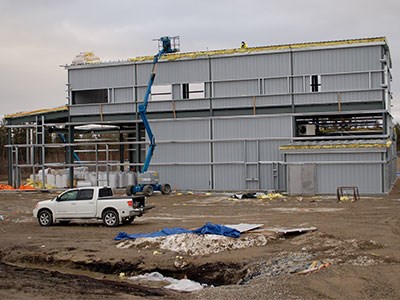Timmins will be known for more than the hometown of renowned hockey greats and a famous country singer.
Its airport will be the site of a joint space agency, research balloon launch, the only one currently in Canada.
The joint program between the Canadian Space Agency (CSA), and France’s Centre National d’etudes Spatiales (CNES), chose Timmins as the best site due to meteorological factors and low population density.
“We looked around from coast to coast to coast at mid-latitude sites and after a six month study, Timmins was chosen,” said Daniel Levesque, senior engineer flight systems with the CSA.
“It also has all the advantages of a big city.”
The research balloons are launched to gather scientific information, demonstrate and test technology, and to train the next generation of aerospace engineers and space scientists.
The space agency’s balloon program, which had been running from the 1980s, was stopped in 2005 due to budget constraints. The French space agency’s balloon program has been running for the past 50 years, but could no longer operate due to population density.
“They were looking around for another country, with a mid-latitude site,” he said. “They wanted wide-open space and low-population density, and we were looking for a way as well to restart our balloon program.”
Canada is providing the launch base and France will fly some of Canada’s pay load, while giving frequent flight opportunities to this country’s scientists and engineers.
The balloons fly to the stratosphere, about 40 kilometres from earth.
“There are very few opportunities to study that layer since it is too high for airplanes and too low for satellites,” Levesque said.
Balloons also allow astronomists to get a clearer view of space.
“When you have atmosphere between what you look at and a telescope, the image is distorted. So putting a telescope on a balloon allows them to get some good science for a relatively low cost,” he said.
While the scientific data gathered varies, balloons were responsible for detecting the depletion of the ozone layer.
“It was really via the balloon that scientists really discovered what was happening to the ozone layer and that eventually lead to laws and regulations for (chlorofluorocarbons) CFCs,” Levesque said. “We realized those gases were destroying our layers.”
A launch campaign will be held every two years, with the goal to increase that to two, every three years.
The campaign lasts about two months and 10 balloons will be launched. It will involve about 100 to 150 people who will be at the base to operate the balloon and manage the payloads.
“One third will be from the French space agency and the Canadian space agency and the rest will be scientists coming from Canada and Europe,” he said.
Three buildings have been erected at a site at the Victor M. Power Airport and the last one is nearing completion. Although it will not be staffed year round, staff will be on site for each campaign for about four to five months for setup and completion. Equipment for each campaign will fill about 15 sea containers and will be brought to Timmins. The first launch is expected in May, 2013.
France also has launch sites in Antarctica, Africa and South America.
“Because we are providing a launch site in Canada, we can gain access to all their other bases so it’s a way to leverage on the limited funding we have,” Levesque said.
The balloons are about 300 metres in height, not including the payload they will carry.
They will fly from two to 12 hours, depending on the data being gathered, and are controlled from the base.
To stop the flight, a rope is detached and the flight chain falls by parachute. It is tracked by GPS, and teams are sent to recover everything.
The balloon is also recovered but can’t be reused. The transponder, radios and electronics can be used again.
“It’s win-win for everyone,” he said. “It will certainly help to put Timmins on the map.”




